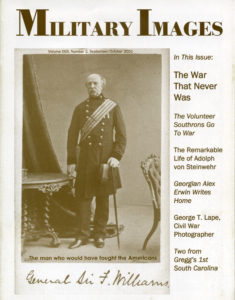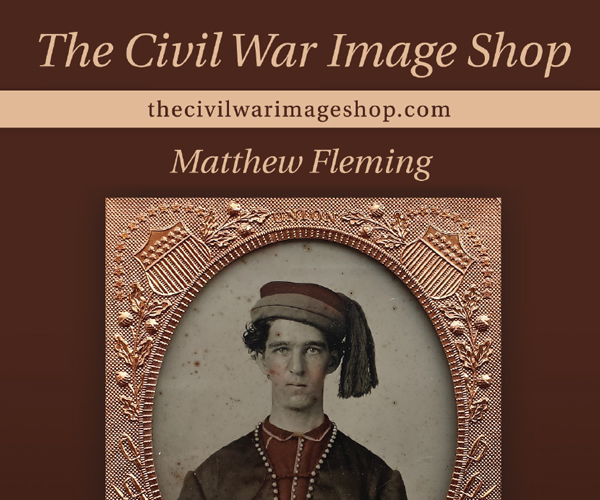The complete issue
Vol. XXIII, No. 2
(40 pages)
Print edition: Visit our store to check availability
Digital edition: Visit JSTOR.org to purchase
Subscribe to MI
Explore the MI Archives: Browse | Advanced search | Tutorial
Inside
Cover image
Lt. Gen. Sir Fenwick Williams, overall commander of Her Majesty’s military forces in Canada, is described as “The man who would have fought the Americans.”
Table of Contents (p. 1)
Mail Call (pp. 2-3)
Feedback includes the partial identification of a group of soldiers pictured in the last Stragglers and a warning from the Curator of History at the Neville public Museum for publishing images without permission.
Passing in Review (pp. 4-5)
Three publications are reviewed, including When This Cruel War Is Over: A Novel of the Civil War (Tom Doherty Associates/Forge Books) by Thomas Fleming, Monitors: The Men, machines, and Mystique (Thomas Publications) by Jerry Harlowe and The Story of a Regiment (North Star Press) by Newell L. Chester.
The Auction Block (p. 6)
A sampling of sales from the popular auction site eBay is included.
The War That Never Was (pp. 7-15)
In late 1861, the U.S. almost went to war with Britain. Canada would have been the main battleground. Heightened tensions resulted between the two nations after James Mason and John Slidell, diplomats of the fledgling Confederacy on a mission to Britain, were detained by U.S. forces as they attempted to cross the Atlantic. Relations between the U.S. and Britain had been somewhat strained since the Revolution and the War of 1812. The text is illustrated with lists of British regiments in Canada and rank badges, plus various orders and other facts. A number of photographs showing British soldiers are included to highlight uniform and equipment details.
Leonard Stineman’s Rough War by Tory Boaz (p. 16)
A member of the 35th and 58th Pennsylvania Infantries, Stineman was severely wounded at the Battle of Fredericksburg. He recovered and barely survived the war, dying in 1867. His wartime portrait illustrates the text.
The Volunteer Southrons’ Trip to the War by Jeffrey Giambrone, Old Court House Museum (pp. 17-20)
A Mississippi volunteer company, the Vicksburg Southrons, waited a long time to get its chance to be sent to the seat of war. The company, 108 men strong, eventually became part of the 21st Mississippi Infantry. They would go on to fight in numerous engagements and lose many of the number before the war’s end. Five portraits illustrate the text, including Pvt. Francis Fogg Weller, Pvt. John Thomas Williams, 4th Sgt. Walter W. Adams and Pvt. Austin Augustus Trescott.
A Life in Images: The Remarkable Life of a General by Hans A. Pohlsander, Phd (pp. 21-23)
Adolph von Steinwehr is one of the lesser-known German officers who attained the rank of general in the Union army. The author tells Steinwehr’s story with various images that include colonial ancestors, a family tree detail, buildings, monuments and two portraits of the subject.
‘We Were in a Tight Place,’ A Letter Home from Lt. Alex Erwin, Phillip’s Georgia Legion edited by Kurt D. Graham (pp. 24-26)
On Sept. 15, 1862, 19-year-old Aleck Erwin wrote his brother back in Habersham County, Ga., describing the Battle of Second Manassas and shedding light on why so many Confederates were missing after the fighting at the Battle of Antietam. A portrait of Erwin illustrates the text.
George T. Lape, Civil War Photographer by Jeff Lape (pp. 27-29)
New York-born Lape (1835-1921) worked as a photographer and civil engineer in his native New York. A gallery of images by Lape includes portraits of Pvt. Thomas H. Carney, Surg. Aaron Dalrymple of the 1st New York Infantry and Hospital Steward Lorenzo E. Fish. Several identified members of the 1st New York Engineers are also included: Asst. Surg. Joseph Walker, Asst. Surg. James McGarry, Lt. Col. James Hall and 1st Lt. Nathaniel M. Edwards.
The River Regiment by Roger D. Cunningham (pp. 30-31)
The 7th Ohio Cavalry saw action throughout the western theater, primarily in Kentucky and Tennessee, including the pursuit of Brig. Gen. John Hunt Morgan’s Confederate raiders across Southern Ohio in July 1863. The regiment’s history is illustrated with portraits of Israel Garrard, Sam Dryden, William D. Ketterman and James H. Wilson. Also included is a portrait of Andrew Alexander, who commanded the brigade to which the 7th belonged.
A Better Man Never Lived by Ron Coddington (p. 32)
The life and times of James Matthews Cooper of the 33rd Iowa Infantry is documented, and the text is illustrated with his portrait.
Two From Gregg’s 1st S.C. by John Mills Bigham (pp. 33-34)
Gregg’s original 1st South Carolina Infantry served six months with the Army of Northern Virginia. Images of two of their members recently came to light: Maj. Edward DuBois Brailsford (1824-1878 or 1879) and Pvt. William Thomas Cribb (1833-1910).
‘Emery’s Sad Fate’ by John N. Ockerbloom (p. 35)
A portrait of Daniel W. Emery, a member of Company F of the 3rd Maine Infantry, accompanies an account of his life and military service. Wounded during the Battle of North Anna, Va., in May 1863, he was taken to a field hospital located in a building that was shelled by the Confederates. Half the wounded in the house were burned to death. Emery did not survive.
Uniforms & History by Michael J. McAfee (pp. 36-37)
In “1st Regiment, New York Light Artillery, 1861-1865,” McAfee details the life, times and style of the regiment. Five portraits are included and four of the men are identified: Col. Charles S. Wainwright, Col. Guilford D. Bailey, Lt. John H. Howell and Pvt. George W. Christman.
Sutler’s Row (pp. 38-39)
The Last Shot (p. 40)
A carte de visite from the Jules Martino collection pictures two Canadian militiamen playing fisticuffs for the photographer.
































